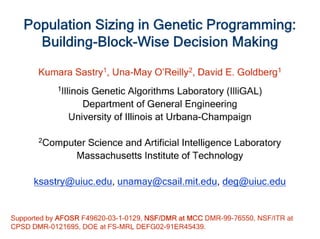Population Sizing for Genetic Programming Based Upon Decision Making
This paper derives a population sizing relationship for genetic programming (GP). Following the population-sizing derivation for genetic algorithms in Goldberg, Deb, and Clark (1992), it considers building block decision making as a key facet. The analysis yields a GP-unique relationship because it has to account for bloat and for the fact that GP solutions often use subsolutions multiple times. The population-sizing relationship depends upon tree size, solution complexity, problem difficulty and building block expression probability. The relationship is used to analyze and empirically investigate population sizing for three model GP problems named ORDER, ON-OFF and LOUD. These problems exhibit bloat to differing extents and differ in whether their solutions require the use of a building block multiple times.



































